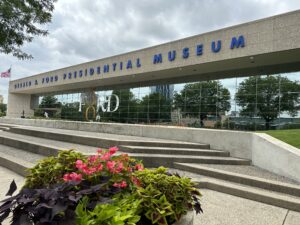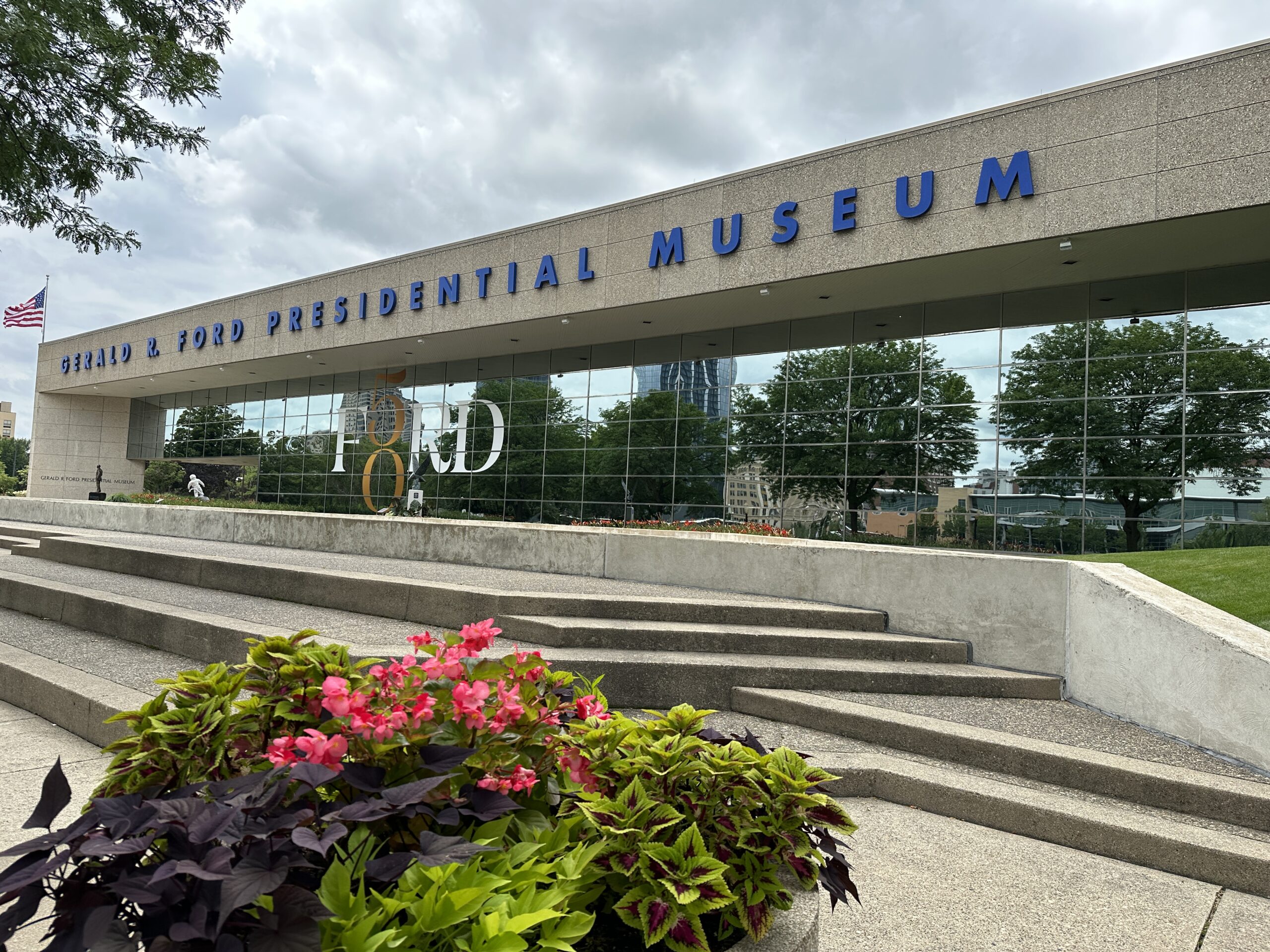The Gerald Ford Presidential Museum was opened in 1979. Perhaps due to the prevailing mood of the country then, it was, in the words of Ford’s son Michael, “kind of dark, almost like going into tunnels.”
Fast forward to 2016, it was completely revamped after a $13 million effort. The result is a presidential library worthy of the 21st century. Unlike other presidential museums, the library is in a separate building in another city. The museum, which is the one most people visit, is in Grand Rapids, Michigan.
The library, which is mostly for scholars, is in Ann Arbor, on the campus of the University of Michigan. Currently, the library has an exhibit of Ford’s sporting life, which includes his early years in football, but also meeting with tennis players. The other exhibit on there now will be of great interest for space buffs.
Even though he was only president for a bit over 2 years (Aug ’74 to Jan ’77), it was a consequential time for the space program: the rollout of the first space shuttle, the first joint manned space mission with the Soviet Union, and the first landing of a spacecraft on Mars. President Ford also opened the Smithsonian National Air and Space Museum in 1976. Another photo from 1976 shows him in the Oval Office being briefed on the space shuttle. The photographs on display go back to 1964, showing Ford on a tour of the Manned Spacecraft Center in Houston; with the crew of Apollo 11; and in 1970 with the astronauts who survived Apollo 13. This display case may be a temporary exhibit, but it is not mentioned on the library website.
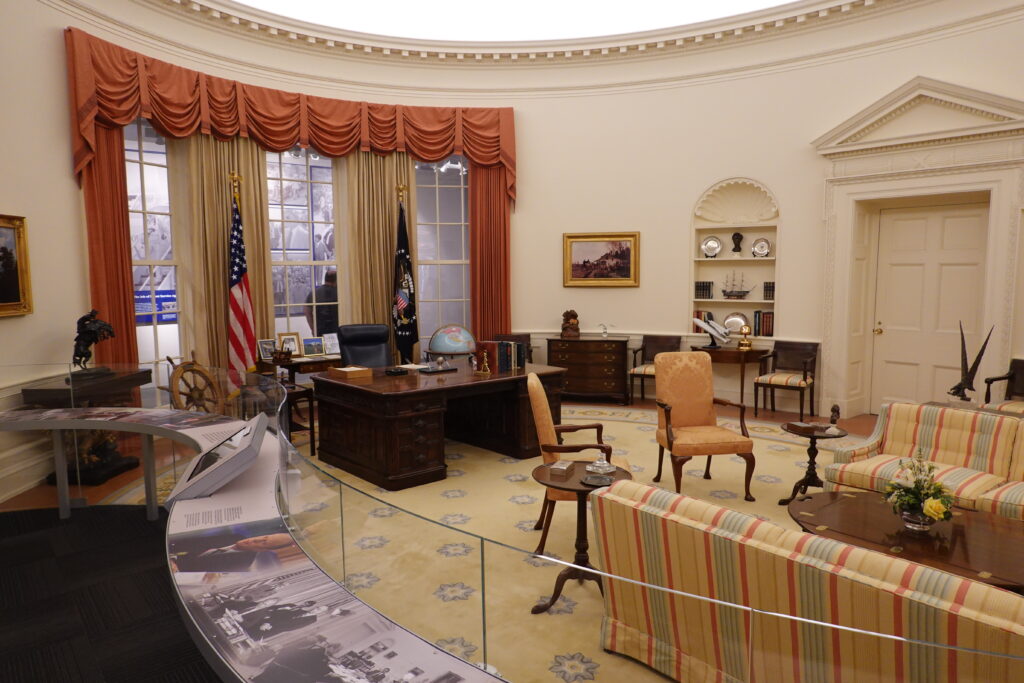
The museum in Grand Rapids has additional space-related items, including several minutes of an audio recording of him speaking to the astronauts of the Apollo-Soyuz mission. There is a mockup of the Oval Office here, decorated just as he had it while president. Just to the right of his desk look for a model of the space shuttle on a small table. On the curving panel that separates visitors from the Oval Office, there are display screens that identify every object on display. One image there shows NASA Administrator James Fletcher presenting the model to Ford. I found it curious he is referred to as a “NASA representative,” considering he was the head of the agency! In any case, the information screen also relays the important information that this was a model of the shuttle named Enterprise, due to Star Trek fans initiating a letter-writing campaign to Ford.
This second iteration of the Ford Museum takes 2 hours to explore. It is characterised by sweeping curved walls upon which are displayed numerous photos and text. One in particular sets out to encapsulate Ford’s persona in three words: trustworthy, conscientious, pragmatic. I’d have to agree with that.
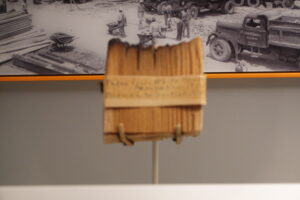
Display cases house artifacts not only from his White House (WH) years, but the past. I found the most interesting item to be one of the smallest: a piece of charred wood that dates to 1814, when the WH was burned during the war. This fragment was recovered between 1949 and 1952 when the WH underwent a major refurbishment.
While a member of the House of Representatives, Ford was appointed to the Warren Commission, tasked with examining the assassination of Pres. Kennedy in 1963. On display is a book Ford wrote about the supposed assassin, Lee Harvey Oswald. Another book here is the Bible Ford used when he was sworn in as both vice president (1973) and president (1974).
A small exhibit on display now is devoted to Watergate. The highlight is Nixon’s notorious tape recorder, on loan from his Presidential Library in California; other items include the rolodex of Judge Sirica, and some artwork drawn at the Watergate trial he was in charge of. When Nixon’s vice president Agnew resigned, he picked Ford from a shortlist of candidates for a replacement. Just a few months later, Ford picked his own VP, Nelson Rockefeller (not much is said about him at the museum).
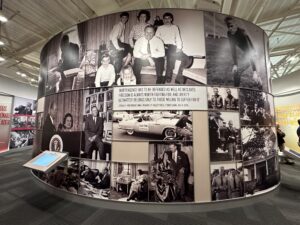
The event Ford’s presidency is most remembered for, and the one that is most often quoted as ensuring he would never be elected President in the ’76 campaign, was his pardon for former Pres. Nixon. While it was framed at the time as “healing the nation,” presidential historians now are of the opinion it was a big mistake [Prof. Julian Zelizer said point-blank “The pardon didn’t work.”; MSNBC, Aug. 13, 2023]. By letting Nixon off the hook, it gave a signal that the worst a future president would ever have to face would be resignation, with no criminal accountability. This is important in the 2020s as we face the fallout of another criminal presidency. One display wall is emblazoned with these words from Ford: “I expect to follow my instincts of openness and candor with full confidence that honesty is always the best policy in the end.” Can you imagine the former president DT ever uttering those words, and actually meaning it? Ford was quite capable of laughing at himself (another trait not shared by DT): one wall has a large photo of him stumbling on the gangway while disembarking a plane in Austria.
The second great trauma that tortured the nation in those days was the Vietnam War. Ford oversaw the end of the war, and also the Bicentennial of the country in 1976. Look back, it’s really astonishing how many critically important events happened under his watch. It was nice to be reminded of it all, in this superbly laid-out museum space.
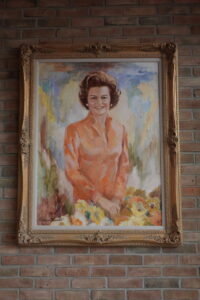
For anyone who has not visited a presidential museum/library, most have certain elements in common. Some of the lavish gifts received by the president from other heads of state are on display; the Oval Office is recreated as it was in that period; paintings of the president and his wife are on display (shown here is a painting of Betty Ford, which is in the Presidential Library); and there is a short film extolling the virtues of the presidency. Unlike other museums, this one features a recreation of the Cabinet Room in the WH, and much is made of the individual cabinet officials who served in his Administration – really well done! Most such museums also include a burial place, and this is no exception. Gerald Ford and Betty are laid to rest here; a sweeping arc wall outside bears their names. I will leave you with a skill testing question: Who was Leslie King?
Photos by C. Cunningham, copyright Sun News
The Ford Library is free to enter. Visit the website for tickets to the Ford Museum.
https://www.fordlibrarymuseum.gov/
